UPCEA, along with American Council on Education and 42 other higher education associations wrote Senate leadership to urge legislation as soon as possible to provide permanent protection for “Dreamers,” young, undocumented, high-achieving individuals who contribute to our college and university system.
Senators Graham and Durbin reintroduced the bipartisan Dream Act of 2019 (S.874), which was first introduced nineteen years ago, that would allow many Dreamers to earn lawful permanent residence in the United States and a path to citizenship. The bill focuses on the special case of talented and productive young people who came to this country at a very young age because of the actions of their parents. They are educated, English-speaking, and grew up with American values and traditions, making them American in every way except in immigration status. But these outstanding individuals are forced to live in an untenable political and legal limbo. They work and pay taxes. They serve in the military and teach in our schools. And tens of thousands of Dreamers have earned or are striving to earn a college degree. They consider America to be their only home. In addition, the House of Representatives recently passed the American Dream and Promise Act (H.R. 6), which would provide a long-term legislative fix for Dreamers, as well as those with Temporary Protected Status and Deferred Enforced Departure, who have seen their status rescinded and also live in uncertainty. Numerous studies have demonstrated that these individuals contribute substantially to the U.S. economy. According to Cato Institute estimates, deporting those with DACA status would cost over $60 billion in lost tax revenue and result in a $280 billion reduction in economic growth over the next decade.
Colleges and universities have seen these remarkable young people up close, in our classrooms and as our colleagues and friends. Despite the challenges they face, they have made incredible contributions to our country and its economy and security. If we are unable to protect them, we will be shutting the door to an entire generation of individuals who seek to contribute their best to America.
The Professional, Continuing, and Online Education Update blog, curated by Ray Schroeder, recently surpassed 1,000,000 views!
The blog has featured daily updates of news, research and trends important to professionals in online and continuing education since December 28, 2010. Every day, Schroeder reviews more than 150 articles, research reports, news releases and other information sources to discover the most relevant and useful pieces to share with readers. In addition to the website views, more than 1,000 readers subscribe to the blog’s daily email list. The blog’s 10,000 archived posts are also searchable via keyword.
“Leaders in our industry use Ray’s blog to keep abreast of the most important new developments and trends in our field,” said Robert Hansen, CEO of UPCEA.
The blog has been curated from the beginning by Ray Schroeder, founding director of the National Council for Online Education at UPCEA and Professor Emeritus and Associate Vice Chancellor for Online Learning at the University of Illinois Springfield. Schroeder has been engaged in online learning since 1997 and is widely recognized as one of the world’s leading experts in online education. As both a faculty member and administrator, Schroeder brings both deep knowledge of and passion for advancing the field of online education—its potential to transform institutions struggling in the new economy, its role in expanding access for time- and distance-challenged students, and its capacity to revolutionize teaching and learning.
Read the blog and subscribe here: https://continuingedupdate.blogspot.com/
And stay connected with UPCEA’s other publications:
- UPCEA Briefing powered by SmartBrief – Our weekly newsletter brings you a quick, two-minute read that will help keep you up-to-date with the news and trends in professional, continuing and online education. Sign up to get these updates.
- Policy Matters – A monthly email with the latest updates and actionable items in public policy for professional, continuing and online education units and other stakeholders of adult and nontraditional education. Sign up to get these updates.
- Unbound – An e-publication in magazine format designed to showcase thought leadership, case studies, research and other valuable contributions to our field. Click here to access.
- Blogs – UPCEA blogs feature posts from industry experts and thought leaders on the latest in professional, continuing and online education, including online learning trends from Ray Schroeder and to benchmarking and research from Jim Fong. Check all of our blogs out here.
Inaugural Forum on the Future of Work: Day 1
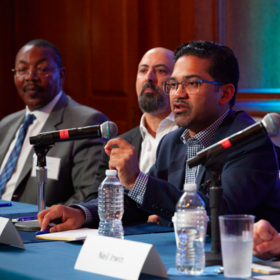 On June 21 and 22, UPCEA and the Columbia University School of Professional Studies (SPS) hosted the Inaugural Forum on the Future of Work.
On June 21 and 22, UPCEA and the Columbia University School of Professional Studies (SPS) hosted the Inaugural Forum on the Future of Work.
The Forum brought together academics and industry leaders to discuss the changing leadership landscape, new ways to nurture employee talent, and the role of education in the coming labor market.
The first day of the Forum included a welcome from SPS Dean Jason Wingard and UPCEA CEO Bob Hansen, and a keynote from Jonathan Law, Partner at McKinsey & Company. A panel on “The Leadership Landscape in the Future of Work” followed, which featured Law, Parchment’s Dr. Matt Pittinsky, National Geographic’s Michael Ulica, TIAA’s Carrington Carter, and was moderated by Wall Street Journal’s Lauren Weber.
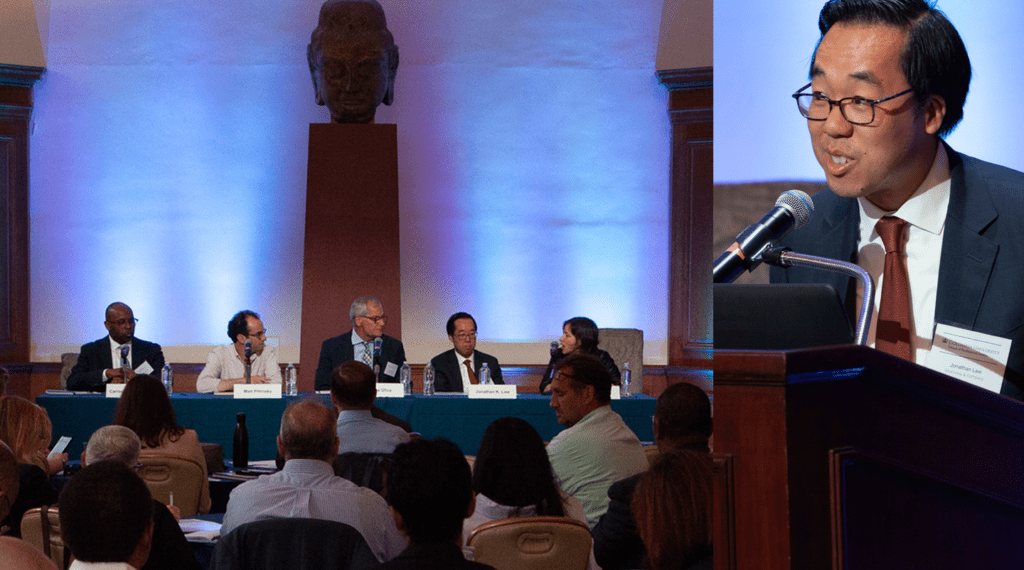
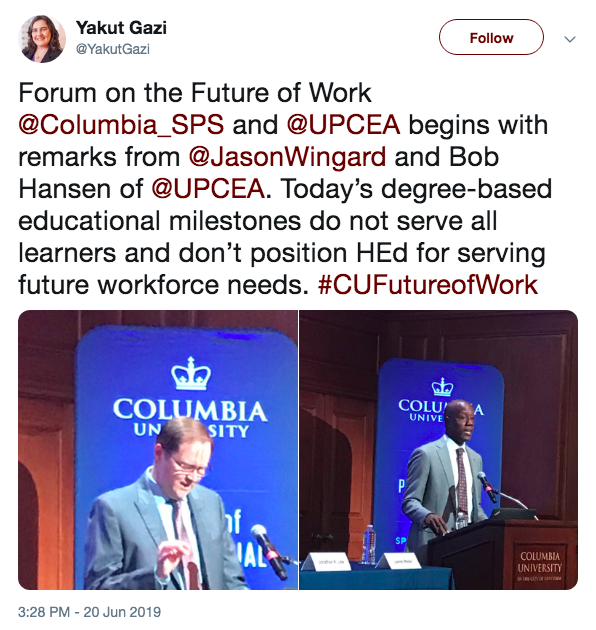
Law’s keynote examined how the advance of artificial intelligence will alter the world of work, and gave an overview of how labor will shift across demographics, region, and industry. Up to 26 million people may need to change occupational groups by 2030.
The panel discussed how higher education can meet the needs of the new labor market that Law introduced. The group stressed the importance of diversifying workforces, expanding curricula offerings, cultivating cognitive and noncognitive skills in the classroom, and supporting faculty on innovative and pedagogical methods.
The panel underscored that a focus on lifelong learning with a growth mindset is essential for success.
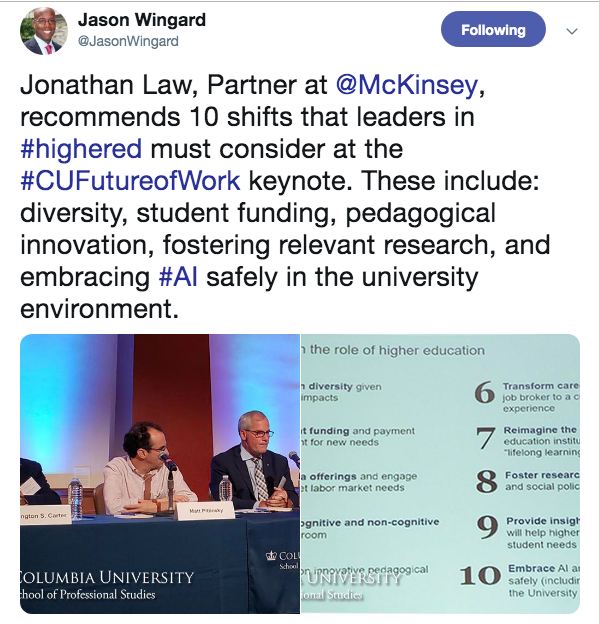 |
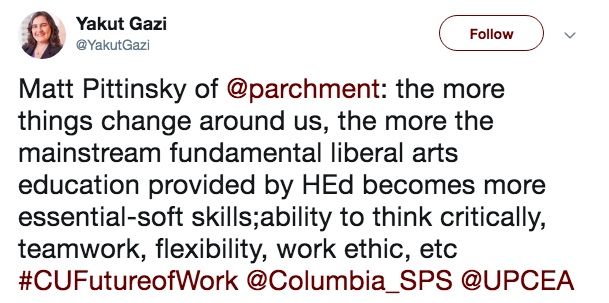 |
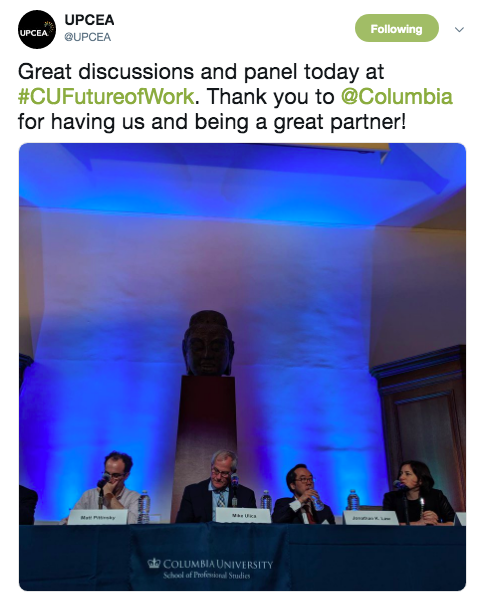 |
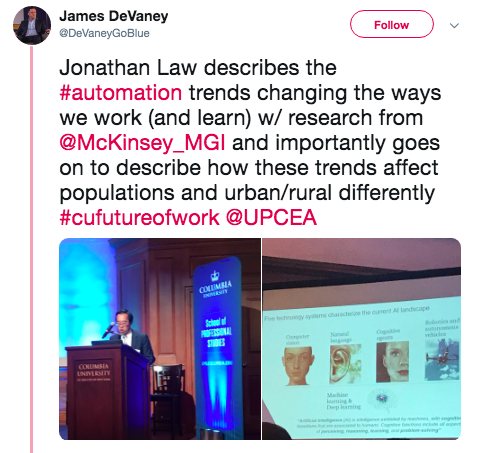 |
The evening concluded with a networking reception.
Inaugural Forum on the Future of Work: Day 2
The second day of the Forum featured panels of business and academic leaders, interspersed with table discussions aimed to advance the ideas presented.
The New York Times’s Neil Irwin moderated, “Talent of the Future: Are We Missing the Mark?,” with Blackrock’s Lance Braunstein, NASA’s Gregory Robinson, and Pfizer’s Dr. Amrit Ray. (Read Dr. Ray’s thoughts here.)
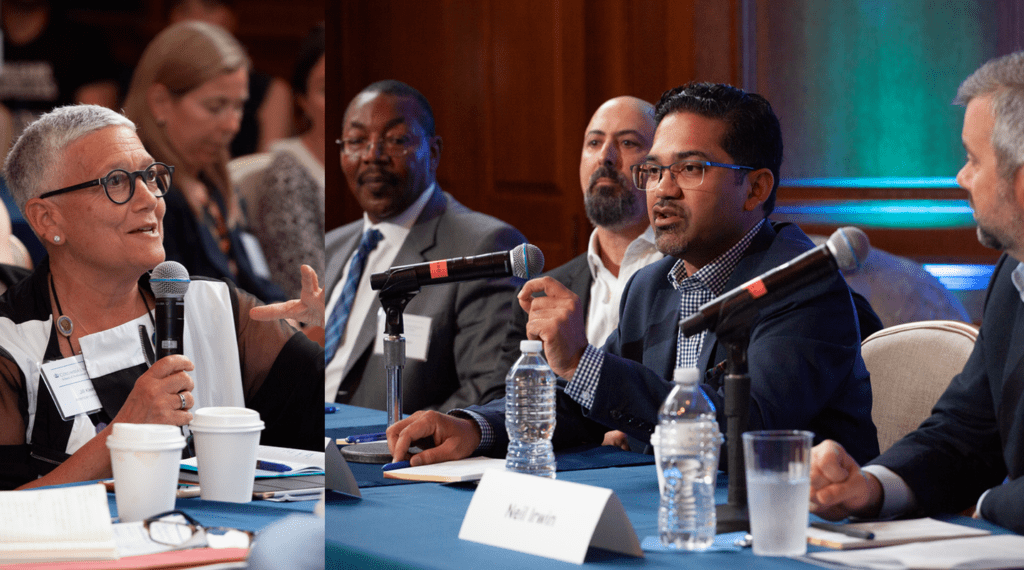
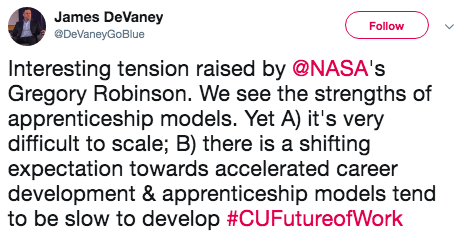 |
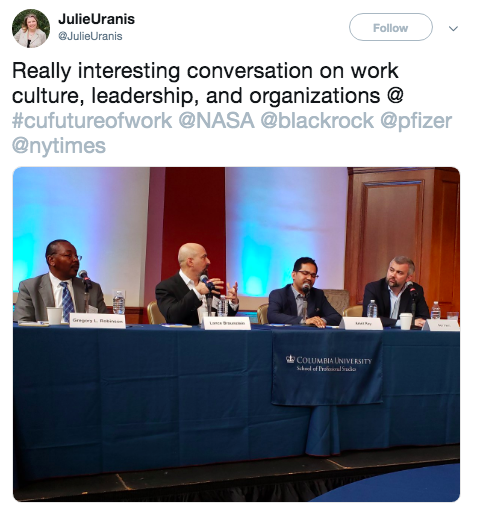 |
The Chronicle of Higher Education’s Goldie Blumenstyk moderated “Higher Education: Still the Solution for a Workforce in Flux?” with Georgetown’s Dr. Kelly Otter, Harvard’s Dr. Chris Dede, and the U.S. Military Academy at West Point’s Dr. Chris Mayer. The challenge for traditional universities is to evolve how they view continuing education, the panel agreed. There should be a stronger emphasis on skill-based learning, and institutions must partner with the private sector to examine existing curricula and how to design the best pipelines for students.
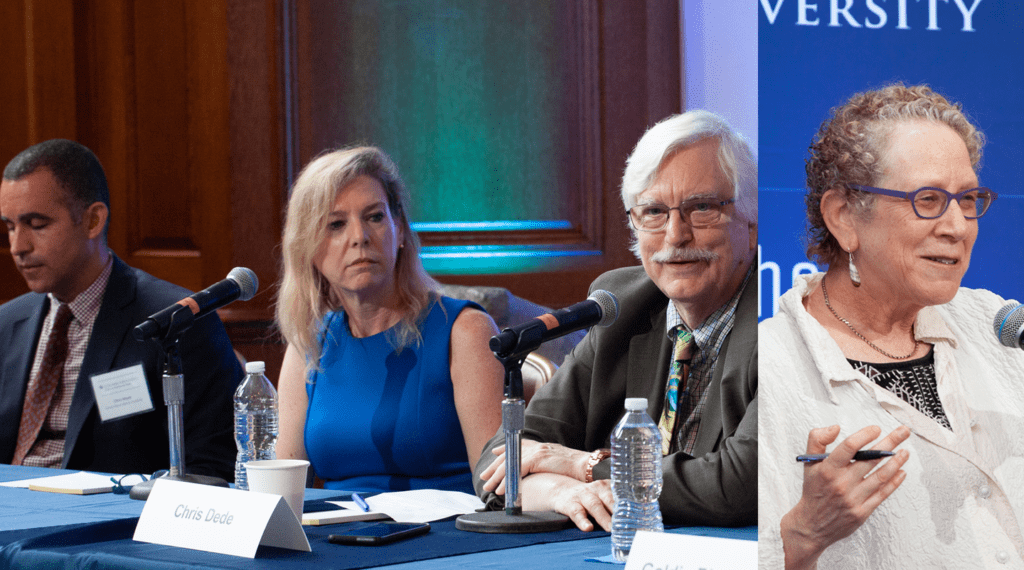
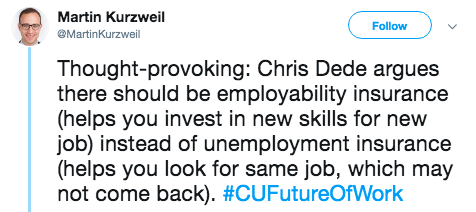 |
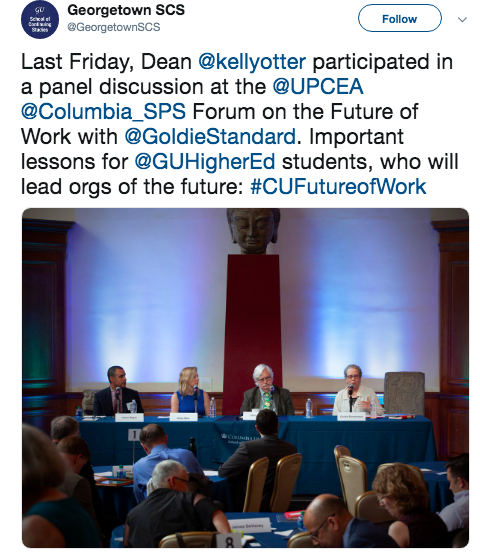 |
The tables were assigned discussion leaders, who encouraged working sessions following the higher education panel. The table discussion leaders included Duke University’s Matthew Rascoff and the University of Michigan’s James DeVaney; Georgia Institute of Technology’s Dr. Nelson Baker and Dr. Yakut Gazi; Marquette University’s Dr. David Schejbal; University of Michigan’s Dr. Earl Lewis and Dr. Alford Young; and The Wharton School’s Dr. Anne Trumbore.
The Forum concluded with “Bridging the Gap Between Learning and Labor,” moderated by Inside Higher Ed’s Paul Fain, and featuring Aspen Institute’s Ross Wiener, Business-Higher Education Forum’s Janet Chen, Carnegie Corporation’s LaVerne Srinivasan, and New America’s Dr. Mary Alice McCarthy.
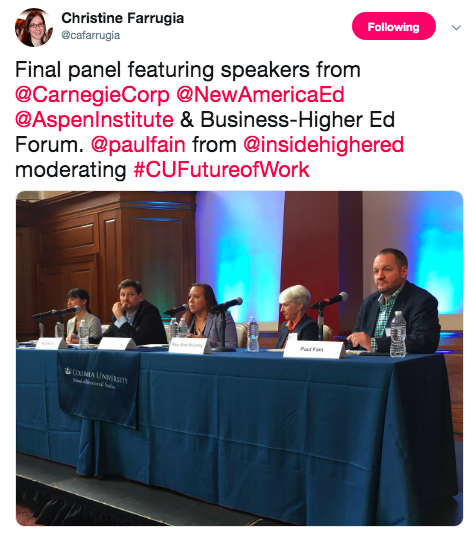 |
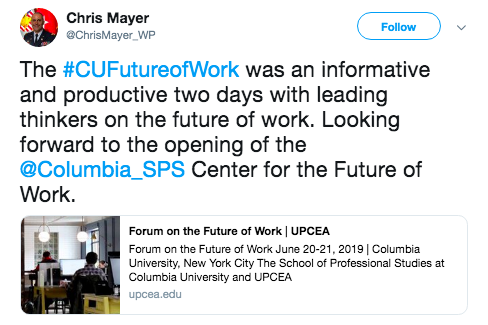 |
Major Updates
- The U.S. Department of Education has released Proposed Regulations for Public Comment.The regulations cover a wide range of topics including changes to accreditation, state authorization, student notifications, and other topics. If finalized before November, these changes would not go into effect until July 1, 2020. We encourage you to comment as an individual, from your private or career perspective, as well as share this information with other leaders involved in government affairs at your institution. Comments are due before July 12, 2019. Read the full rule and submit a formal comment.
- Senator Elizabeth Warren has recently gained the support of James Clyburn, a top ranking House Democrat, to create a stronger bi-cameral push for her plan to remove up to $50,000 of student loans for 42 million Americans. Their estimates say the bill would cancel student debt entirely for 75% of borrowers.
- The Education Department’s student aid chief, Mark Brown, who oversaw $1.5 trillion in student loans, has resigned amid ethics questions related to his board member role within a non-profit foundation. Mr. Brown, who headed the Office of Federal Student Aid starting in March, serves as a board member of the KnowledgeWorks foundation, which holds approximately $30 million in federal student loans, which was seen as a potential conflict of interest.
Other Reads
- U.S. says $168 million ITT for-profit student loans to be forgiven 6/14/19 (Reuters)
- Trump administration reviewing foreign funding at U.S. colleges 6/13/19 (PBS NewsHour)
- House passes immigration bill to protect ‘dreamers,’ offer a path to citizenship 6/4/19 (Washington Post)
We’d like for your input! Like this format? Submit comments, or ideas for topics of inclusion in this newsletter. For more information on UPCEA government affairs, contact Jordan DiMaggio ([email protected]).
By SmartBrief Editors
This post is produced in partnership with UPCEA.
The idea of offering free access to community college, and even entire degree programs, has gained steam in recent years. CNBC reports that 11 states in the country offer at least some tuition-free community college programs to qualified students and nine more have these programs in the works.
The Organisation for Economic Co-operation and Development reports that the United States is 10th in the world in postsecondary attainment.
When people think about free community college, America’s youth spring to mind–young people who will be evaluating colleges in the next decade. But young people are not the only ones who stand to gain from these programs. Professional, continuing education and online education could see a boost if tuition-free community college programs expand.
Increasing access to postsecondary credentials can change minimum qualifications for some fields. Further, those who already have a college degree or certification will need to upskill or update their level of knowledge to keep up with the new crop of professionals coming to the table with similar qualifications. In most cases, this will mean industry-specific professional certifications and advanced degree programs often offered by professional, continuing and online divisions of colleges and universities.
As tuition-free community college programs continue to roll out nationwide, online and professional learning programs will need to take note. Non-community college based providers will need to demonstrate their value, and learner-focused attributes, including accelerated timelines, rigorous curricula and relevant, job-focused certifications. It will mean a harder fight for the dollars that corporations and individuals put toward professional development. Colleges and universities should already be thinking about how they will stand out. The change is already underway – will your institution be ahead of the curve?
No longer is marketing just the development of a catalog, viewbook, brochure or billboard. It now includes marketing strategy and customer engagement as well as brand management. In an evolving economy fueled by data analytics, making wise marketing resource and infrastructure decisions is critical. Earlier analyses have shown that there has been a clear shift toward digital media spending and dedicating resources toward having a marketing competency has become foundational to competing in the professional, continuing and online (PCO) education market. The 2018/19 UPCEA Marketing Survey shows that for every eight PCO employees hired, one is a marketing team member (Table 1). Smaller PCO units may be more likely to either have existing non-marketing staff do marketing tasks, use centralized marketing resources or potentially outsource the function.
Table 2 shows a metric that could be important in how an institution might grow its marketing staff with revenues. This suggests that for every $3.7M of revenue an institution generates, a marketing staff member should be added. Further interpretation might also suggest that in start-up mode or when a PCO unit is new, the metric or revenue expectation should be under $1M or roughly $977K per marketing staffer.

Further refinement of the survey results may also suggest marketing resource allocation could be set at different levels. For example, overall, there is a baseline of 1.51 FTEs, which could include a marketing director and a part-time administrative person. Marketing staff would be added for every $2.63M of revenue in this situation. In a small PCO scenario, a linear regression identifies 1.71 as the baseline FTEs. However, given the small sample size and cluster of points with less than $1M in revenues and 1 FTE, one could argue that a start-up or small PCO unit might start with one marketing professional, such as a manager, coordinator or even a director.
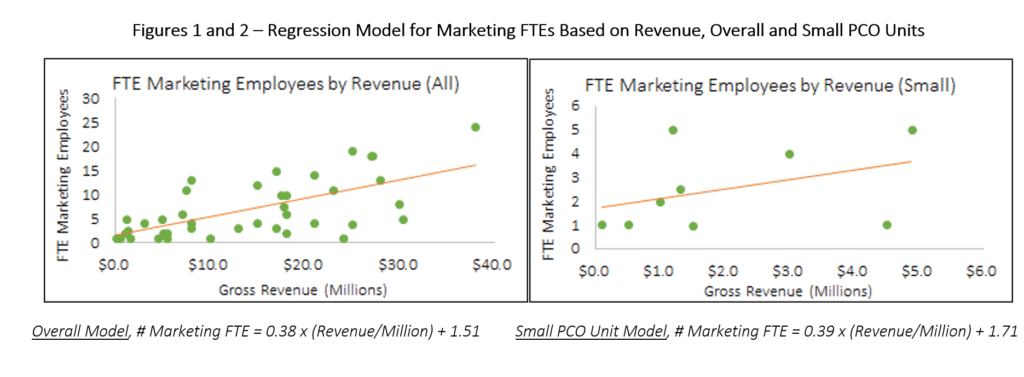
The limitation of the model and analysis is that it looks at past and recent UPCEA member survey results and may not adequately prepare the unit of the future or one that wants to compete more aggressively. For larger PCO units, it should be assumed that economies of scale are likely to be achieved, and thus, this end of the model may be less reliable or predictive and that a bootstrapped or alternative model may be more relevant. Also, the role of real-world and intuitive decision making should come into play to adapt the results of this research to the institution’s or unit’s goals and propensity for risk. The analysis becomes more difficult to predict with the growth of outsourcing. Seventy-nine percent of PCO units outsource at least some of their marketing needs, with 3% outsourcing all of it (Table 3). On average, PCO units have spent $78,369 on outsourcing, with large institutions spending the most ($121,880) and small institutions the least ($10,137). Most of the marketing outsourcing is for digital marketing activity, as on average, PCO units spent 63% of their outsourcing dollars on electronic marketing. Overall, outsourcing costs could amount to 9% of the entire marketing budget, which includes labor, media and other operational items.
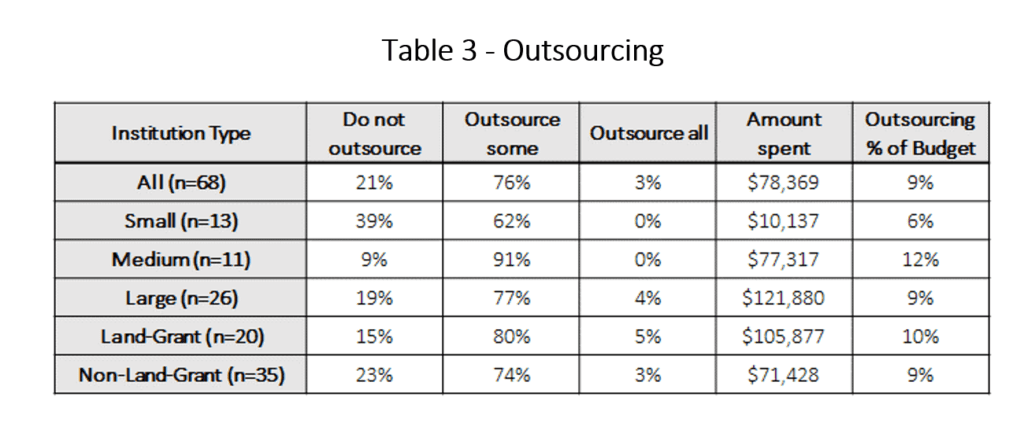
Having or outsourcing a marketing competency appears to be a necessity in order for a PCO unit to compete. Whether the unit chooses to market through an existing relationship with an Online Program Management (OPM) provider, use of an outsource marketing partner, central college or university marketing support, or creating a free-standing marketing unit within the PCO unit, marketing is a strategic function that should be planned and resourced appropriately based on the institution’s goals for the future.
PCO leaders and their marketers must address the following issues as they move into a changing market for higher education:
- How much should the PCO unit invest in marketing resources, including personnel, partnerships and media?
- How complex is the portfolio, competition or marketing objective in that decisions need to be made to build or outsource marketing functions?
- Can the central marketing unit of the greater institution effectively market PCO programs? Can central marketing effectively market degrees, certificates and other credentials aimed at adult and corporate learners?
- How much should a PCO unit invest in marketing new programs along with maintaining enrollments for existing programs?
- Can the PCO unit attract marketing talent to achieve enrollment and strategic goals?
- How will the PCO unit measure performance and accountability of marketing efforts?
The convergence of dramatic changes in higher education and the increase in social and digital technologies has prompted the demand for marketing leaders who are skilled at reaching the different constituents in today’s adult learner market. UPCEA has a robust network of marketing and enrollment professionals and conferences to help address many of these challenges.
Blockchain is evolving into a robust platform that may shake many aspects of higher ed.
We all have heard much about the potential for blockchain, particularly how it might serve as a distribution, validation and secure ledger of transcripts and associated certifications. MIT did the early work on this. Two years ago they began offering the distribution of diplomas via the Blockcerts Wallet app. While that sounds geeky-cool, it represents much more than a technological advance. Substantively, it shifts control of transcripts from the Registrar to the student. No longer can an unpaid parking ticket delay the delivery of your transcript to a prospective employer.
Chris Jagers, co-founder and CEO of Learning Machine. “MIT has issued official records in a format that can exist even if the institution goes away, even if we go away as a vendor,” Jagers says. “People can own and use their official records, which is a fundamental shift.” That is huge because it may ultimately be paired with non-university credentials such as internships, MOOCs, and an assortment of badged gigs representing short-term work in related fields. The student will be able to assemble her/his own transcript of relevant materials that can more fully reflect experiences and masteries.
Sara Friedman from THE Journal recently wrote about one of the most valuable and enduring features of Blockchain is the use of blockcerts:
“Blockcerts is a global open standard for anchoring any type of document to any blockchain as secure anchor of trust,” said Natalie Smolenski, senior vice president of business development at Learning Machine. “The blockchain basically serves as a kind of global notary for these academic records, so that even if the issuing institutions can’t be contacted anymore or the software vendor that was used to issue that record goes out of business or doesn’t support that product anymore, recipients still have their documents and they can verify them for life.”
In the 2019 annual Horizon Higher Education Edition report, now published by EDUCAUSE, blockchain tops the list of important developments in educational technology for higher ed in the four to five year horizon. The technology is here and the number vendors is expanding, but higher ed and HR departments need a bit more time to get up to speed on the blockchain.
Despite US initiatives to drive the technology forward, China is taking the lead in this field. Chinese firms have filed the most blockchain patents and, as the University of Pennsylvania’s Wharton school has recognized, blockchain is an official national priority:
“The Chinese State Council included its development in the nation’s 13th Five-Year Plan. And last year, President Xi Jinping said China seeks to lead in innovation worldwide, citing blockchain, AI, the Internet of Things and other technologies as the driving forces.”
In April of this year, nine universities announced their collaboration on blockchain to give students a digital record of academics, badges, certificates and more. “The U.S. institutions involved in the project are Harvard University, the Massachusetts Institute of Technology (MIT), and the University of California System’s Berkeley and Irvine campuses. Such digital records would allow students to securely own and share their information instead of having to go back to the relevant institution each time they need proof of their accomplishments”, said Sanjay Sarma, MIT’s vice president for open learning, regarding the collaboration.
How do we plan and prepare to use this powerful new distribution, validation and secure network? New America has released the Blockchain Trust Accelerator Blueprint for Blockchain and Social Innovation. Calling it “a guide to blockchain technology for public sector and social impact leaders,” it delivers recommendations, case-studies and insights on many aspects of the future of blockchain.
The Blueprint includes a most useful eleven-point checklist for deploying a blockchain-powered solution. From defining your challenge through ethical considerations, assessing risks and assuming “unknown unknowns” the list is a great place to begin preparing for the blockchain.
